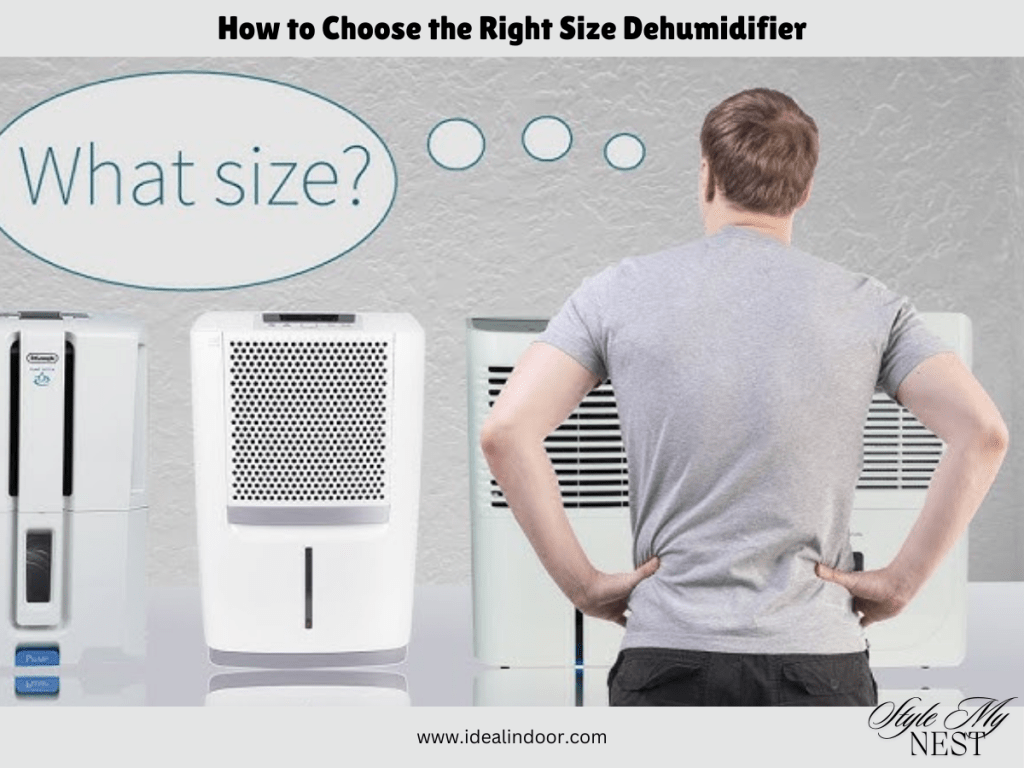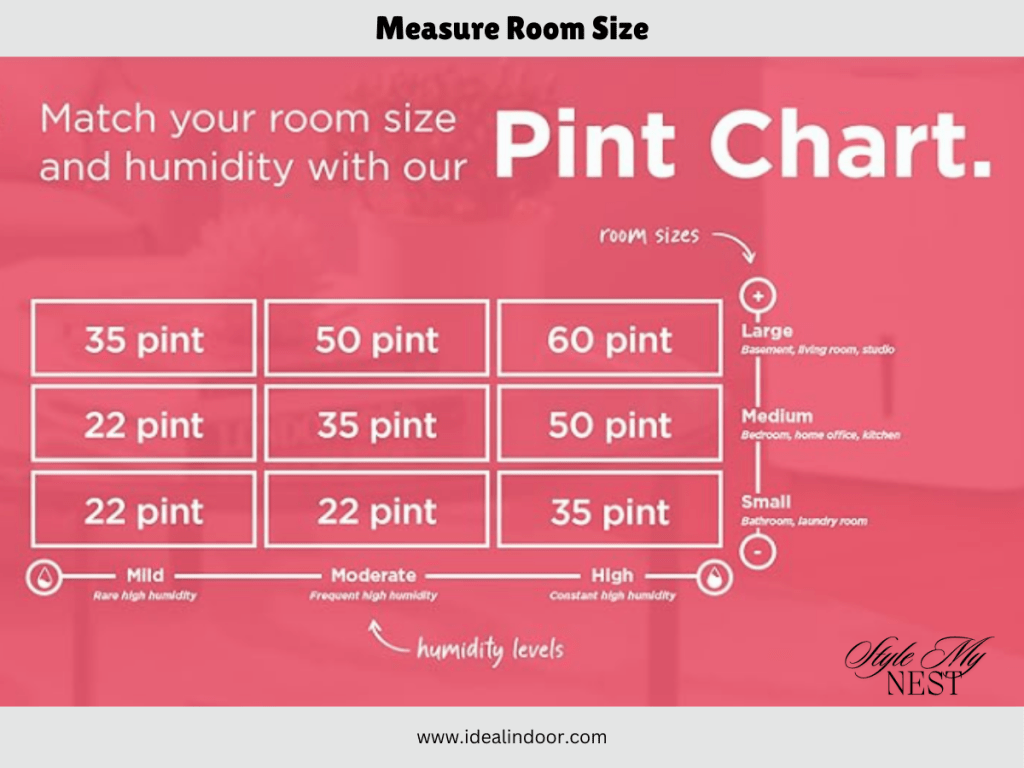When it comes to keeping your home comfortable and healthy, moisture control is key. Choosing the right dehumidifier size can make all the difference between a space that feels cozy and one that feels like a swamp. The wrong size can either leave your space feeling damp and musty or cost you more in energy bills than necessary.
Let me share a quick personal story—several years ago, I bought a dehumidifier for my basement without paying attention to its size. I figured “bigger is better,” so I grabbed the largest one in stock. Not only did it use more power than I needed, but it also made the room feel strangely dry and uncomfortable. I learned the hard way that size really does matter! In this guide, I’ll help you avoid making the same mistakes and even suggest some of the best dehumidifiers available on the market to fit your needs.

How Dehumidifiers Work
Dehumidifiers are designed to pull excess moisture from the air, helping you maintain a comfortable and healthy indoor environment. Whether it’s the sticky summer months or a persistently damp basement, a dehumidifier can do wonders in reducing humidity. But if it’s not the right size, you might end up running it all day without getting the results you need.
A dehumidifier that’s too small will work overtime, burning through energy without properly controlling moisture levels, while one that’s too large can dry out the air too much, leaving your space uncomfortable.
Key Factors to Consider
There are several important factors to consider when choosing the right size dehumidifier. Let’s break them down.
Room Size
The most obvious factor in determining the right size dehumidifier is the size of the room or space. But square footage alone isn’t enough; ceiling height and airflow also come into play. For example, high-ceilinged rooms will need a stronger dehumidifier than standard rooms.
For medium to large spaces like living rooms and bedrooms, the Frigidaire 50-Pint Dehumidifier (FFAD5033W1) is a fantastic choice. It’s capable of handling rooms up to 1,200 sq. ft. with ease.
Level of Humidity
Not all rooms have the same humidity levels. Basements, bathrooms, and laundry rooms generally have more moisture, meaning they require larger dehumidifiers. Bedrooms and living rooms, on the other hand, typically have moderate humidity.
For areas with high moisture levels, like basements, a larger dehumidifier like the Keystone 50-Pint Dehumidifier is a great option. It’s especially good at tackling dampness in large spaces or heavily used rooms.
Climate and Location
Your local climate also plays a role in selecting the right dehumidifier size. If you live in a particularly humid region, you’ll need a unit that can handle consistently high moisture levels.
If you’re in a high-humidity area like Florida, you’ll need a larger unit. A great pick for these situations is the Keystone 50-Pint Dehumidifier—strong enough to manage persistent moisture in big spaces.
Calculating the Right Dehumidifier Size
Now that you know what factors to consider, let’s look at how to calculate the exact dehumidifier size you need. Dehumidifiers are rated based on how many pints of water they can remove from the air per day, known as Pints Per Day (PPD).
Understanding Pints Per Day (PPD)
A dehumidifier’s PPD rating tells you how much moisture it can remove from the air in a 24-hour period. It’s crucial to match the PPD to the size of your space and the moisture levels.
The Calculation Formula: Step-by-Step
Here’s how to calculate the size of the dehumidifier you need based on room size and moisture levels.
Measure Room Size
You’ll need to know the square footage of the room. To calculate this, multiply the length by the width of the room.
If your basement is 20 feet long and 15 feet wide, the area would be 300 square feet (20 x 15 = 300).
Determine Humidity Level
Humidity levels can be categorized as:
- Slightly damp (50-60% humidity)
- Moderately damp (60-70%)
- Very damp (70-80%)
- Wet or extremely humid (80%+)
You can buy a hygrometer to measure the exact humidity level, or you can estimate based on how the room feels. A damp basement might feel clammy with noticeable moisture on the walls, indicating higher humidity.
Use the Sizing Guide
Most manufacturers provide a sizing guide, and the Association of Home Appliance Manufacturers (AHAM) has a general recommendation that looks like this:
- 300-500 sq. ft. with slightly damp air: 20-30 PPD
- 500-1,000 sq. ft. with moderately damp air: 30-50 PPD
- 1,000-1,500 sq. ft. with very damp air: 50-60 PPD
- 1,500-2,000 sq. ft. with wet or extremely humid air: 60-70+ PPD
Apply the Calculation to Your Room
Let’s say you have a 700-square-foot basement that’s moderately damp (around 70% humidity). You’d need a dehumidifier capable of removing about 50-60 pints of water per day. Here’s the breakdown:
- Room Size: 700 sq. ft.
- Humidity Level: Moderately damp (70%)
- Recommended PPD: 50-60 PPD
For this situation, a dehumidifier like the Frigidaire 50-Pint Dehumidifier would be a perfect match. It’s large enough to handle a medium-sized, moderately damp basement without being overkill. If your basement were larger or more humid, you could look at models that remove even more moisture, like a 70 PPD unit.
Is It Better to Undersize or Oversize a Dehumidifier?
In general, oversizing your dehumidifier is better than undersizing it. A dehumidifier that’s too small will run constantly but never fully remove the excess moisture. Meanwhile, an oversized unit will be more energy efficient because it won’t need to run as long or as frequently to achieve the desired results.
The Disadvantage of Undersizing a Dehumidifier
Many homeowners make the mistake of opting for a smaller, more affordable dehumidifier, thinking it will get the job done while saving energy. However, undersizing a dehumidifier can lead to several significant problems that can affect both comfort and air quality in your home.
Inefficient Humidity Control
An undersized dehumidifier will have trouble keeping up with the room’s moisture levels, especially in areas that are highly humid or prone to excess moisture, like basements or bathrooms. A small unit can only extract so much water from the air each day, and if the moisture levels are high, it will never be able to keep up. As a result, the space will continue to feel damp, and your dehumidifier may not reach the desired humidity level.
According to indoor air quality specialists, when a dehumidifier is undersized, it will struggle to achieve the recommended 30-50% relative humidity, especially in spaces with high humidity like basements. As a result, issues like mold and mildew growth may persist, despite the dehumidifier running constantly.
How Energy Efficiency Impacts Dehumidifier Sizing
Many people assume a larger dehumidifier automatically means higher energy costs, but that’s not always true. If your dehumidifier is the right size for your space, it won’t need to run as long or as hard, which actually makes it more energy efficient.
Look for Energy Star-rated dehumidifiers, which are designed to use less energy while still maintaining excellent performance.
Common Mistakes to Avoid When Sizing Your Dehumidifier
When shopping for a dehumidifier, avoid these common mistakes:
- Buying based solely on price: Cheap units may seem like a good deal, but if they don’t meet your space’s needs, you’ll end up paying more in the long run.
- Ignoring humidity levels: Always consider how damp your space is before making a purchase.
- Undersizing: Getting a unit that’s too small will leave you frustrated with poor results.
How to Maintain Your Dehumidifier for Maximum Efficiency
Once you’ve chosen the right size dehumidifier, regular maintenance is key to keeping it working efficiently. Clean the filter every few weeks, empty the water tank as needed, and check for any signs of wear and tear to extend the life of your unit.
Finding the Perfect Balance
Choosing the right size dehumidifier is all about balance. By considering factors like room size, humidity levels, and climate, you can select a dehumidifier that keeps your space comfortable and energy-efficient. Don’t make the mistake of going too small or too big—take the time to do the math and get it just right!
With the right-sized dehumidifier, you can finally say goodbye to excess moisture, mold, and allergens, and hello to a fresher, more comfortable living space.
AQ Section: How to Choose the Right Size Dehumidifier
1. How do I know what size dehumidifier I need?
To determine the right size dehumidifier, you should calculate the square footage of the area you want to dehumidify and consider the humidity level. Most manufacturers provide a chart that correlates room size with the appropriate PPD (Pints Per Day) rating. For example, a 1,000 square foot area typically requires a dehumidifier with a capacity of around 30-50 PPD, depending on humidity levels.
2. Is it better to undersize or oversize a dehumidifier?
It’s generally better to oversize a dehumidifier slightly rather than undersize it. An oversized unit can effectively remove moisture more quickly and maintain optimal humidity levels without running continuously. Conversely, an undersized unit may struggle to keep up with humidity, leading to higher energy costs and potential mold issues.
3. What happens if I choose the wrong size dehumidifier?
Choosing the wrong size can lead to inefficient moisture removal. An undersized dehumidifier may run constantly, increasing energy bills and failing to adequately control humidity, which can foster mold growth. An oversized unit might over-dry the air, causing discomfort and leading to dry skin or respiratory issues.
4. Can I use a dehumidifier in multiple rooms?
Yes, but it may not be as effective. Dehumidifiers are generally designed for specific spaces. If you plan to move it between rooms, consider how well it performs in each area based on size and humidity levels. If you’re frequently shifting it, a portable unit with adequate PPD for the largest space may work best.
5. How do I maintain my dehumidifier?
Regular maintenance is crucial for optimal performance. This includes:
- Cleaning or replacing filters according to the manufacturer’s instructions.
- Emptying the water tank frequently (if not using a continuous drainage option).
- Wiping down the exterior and ensuring vents are clear of dust and debris.
- Checking for leaks or unusual noises that may indicate a problem.
6. What is the average lifespan of a dehumidifier?
The average lifespan of a dehumidifier is typically between 5 to 10 years, depending on the brand, usage, and maintenance. Regular upkeep can help extend the lifespan of your unit.
